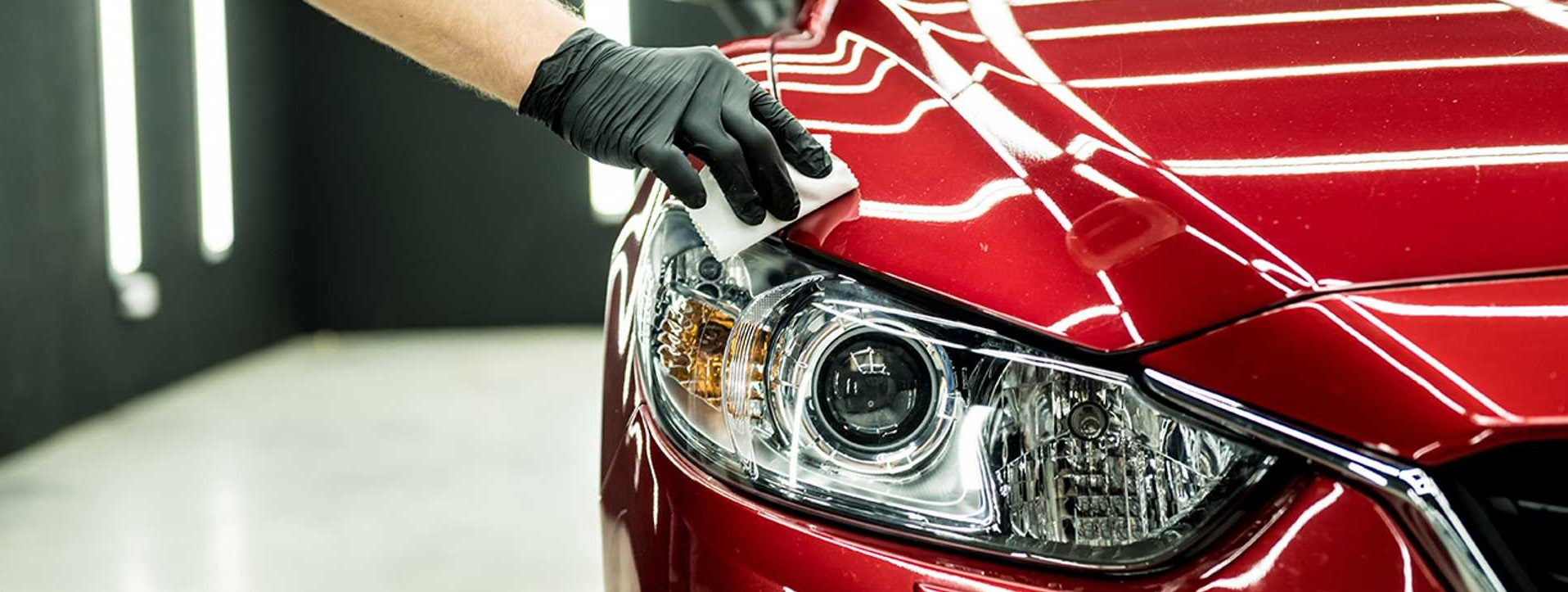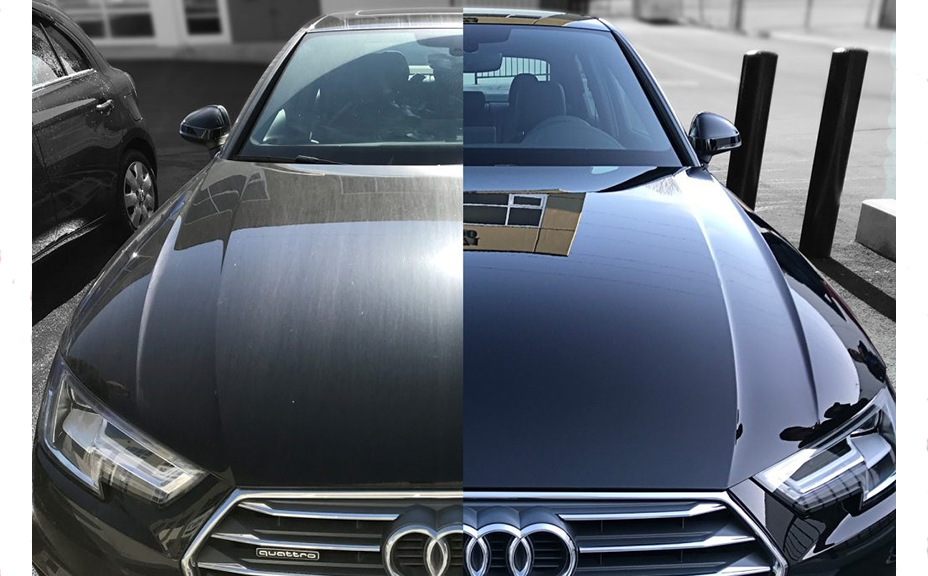Checking out the Science Behind Car Ceramic Coating and Its Safety Properties
The science of car ceramic coating provides a remarkable research study in sophisticated automotive defense. Composed primarily of silicon dioxide and polymers, these coatings develop a robust bond with car paint. This communication improves resilience against ecological dangers while offering hydrophobic advantages. However, the complexities of how these coatings job and their long-lasting benefits stay much less understood. Unboxing these information reveals why ceramic layers are ending up being a recommended choice for automobile treatment
What Is Ceramic Coating?
Ceramic coating is a fluid polymer that chemically bonds to the surface of a car's paint. This advanced safety layer improves toughness and supplies premium resistance to ecological factors. Unlike typical wax or sealers, which give momentary security, ceramic coverings develop a durable shield that can withstand extreme conditions such as UV rays, acidic contaminants, and extreme weather. When used correctly, the coating forms a hydrophobic surface area, triggering water to grain and slide off, which assists in maintaining the automobile's cleanliness. In addition, it uses enhanced gloss and deepness to the paint, making the vehicle show up even more refined and vibrant. The application procedure normally entails thorough surface preparation, including cleaning and polishing, to assure peak bonding. Therefore, ceramic coatings are ending up being increasingly prominent amongst car enthusiasts and those looking for to protect their financial investments, assuring to keep the lorry's visual appeal while reducing the frequency of maintenance.
The Composition of Ceramic Coatings
The detailed formula of ceramic finishings primarily consists of silicon dioxide (SiO2), which is derived from natural resources like quartz and sand. This key component offers the foundation for the coating's toughness and protective high qualities. Along with SiO2, ceramic coverings commonly consist of numerous polymers and additives that enhance bond, versatility, and resistance to ecological variables. These substances work synergistically to produce a durable barrier against pollutants such as dirt, chemicals, and UV rays.Furthermore, some formulas include titanium dioxide (TiO2) or various other nanomaterials, which can boost the coating's hydrophobic homes, leading to better water repellency. The accurate structure can vary substantially amongst suppliers, influencing performance and durability. Eventually, the combination of these elements culminates in a safety layer that not just improves the aesthetic appeal of vehicles but additionally offers to prolong their lifespan by shielding the surface area from possible damages.
Exactly How Ceramic Coatings Work
Comprehending how ceramic coatings function includes exploring their chemical composition, which adds to their protective high qualities. The application process is essential for achieving excellent outcomes, while longevity and resilience factors establish the coating's performance gradually. Together, these components highlight the advantages and efficiency of ceramic layers for vehicle protection.
Chemical Make-up Explained
While several car owners seek durable security for their vehicles, the chemical structure of ceramic layers plays an essential duty in their effectiveness. These coatings mainly contain silicon dioxide (SiO2), which is stemmed from natural minerals. This substance creates a strong bond with the vehicle's paint, developing a durable, safety layer. Furthermore, several ceramic finishes contain titanium dioxide (TiO2), improving their hydrophobic residential properties and resistance to UV rays. The presence of polysiloxanes can better improve versatility and resilience. Together, these aspects add to the coating's capability to repel water, dust, and impurities, while also supplying a high-gloss coating. Understanding this chemical structure helps car owners value the durable defense offered by ceramic finishes.
Application Process Summary
Applying ceramic finishes entails a precise process that assures optimal bonding and protection for the vehicle's surface area. Complete cleansing and purification of the car's outside are done to get rid of dust, grime, and previous waxes. This step verifies that the surface is devoid of impurities that could prevent adhesion. Following this, the paint is frequently brightened to enhance clarity and remove any flaws. When prepared, the ceramic coating is used in little sections using an applicator pad, allowing for uniform coverage. The coating is then delegated treat, forming a strong chemical bond with the surface. Correct treating times and problems are vital, as they verify the coating accomplishes its maximum efficiency and protective qualities.
Durability and Toughness Elements
Ceramic coverings are developed to offer resilient security through their innovative chemical make-up, which produces a robust barrier against ecological impurities. The longevity of these layers is affected by aspects such as the thickness of the application, the top quality of the item, and the problems under which the car is revealed. High-grade ceramic finishes can last a number of years, resisting scratches, UV rays, and chemical stains. Proper upkeep, including normal washing and routine reapplication, can even more enhance durability. In addition, ecological factors like environment and direct exposure to contaminants can influence the life expectancy of the coating. On the whole, when used and preserved correctly, ceramic finishes use phenomenal durability, making them a prominent option for car enthusiasts seeking to preserve their car's look.
Hydrophobic Residences and Water Repellency
Hydrophobic homes are a trademark of quality car ceramic finishes, considerably enhancing the lorry's surface area performance. These finishes produce a molecular bond with the car's paint, causing a surface that repels water properly. When water enters into call with a ceramic-coated surface, it beads up and rolls off, minimizing the amount of fluid that remains on the paint. This behavior not only contributes to a visually pleasing look yet additionally lowers the accumulation of impurities such as dirt, grime, and road salts.The look at more info improved water repellency leads to simpler this content cleaning and maintenance, as much less initiative is called for to get rid of undesirable substances. On top of that, the hydrophobic nature of ceramic layers aids in stopping water spots, which can mar the finish of uncoated surface areas. Generally, the consolidation of hydrophobic buildings in ceramic coverings plays a vital role in maintaining the vehicle's pristine look while simplifying maintenance.
Security Against Scratches and UV Damage
Car ceramic layers supply significant protection versus scrapes and UV damage. The scrape resistance mechanism produces a sturdy layer that soaks up effects, while the UV shielding advantages assist maintain the lorry's paint stability in time. With each other, these functions add to a longer-lasting and aesthetically appealing coating.
Scrape Resistance Device
Utilizing sophisticated modern technology, ceramic layers offer a durable shield versus scratches and UV damages, enhancing the long life and appearance of car surfaces. The scratch resistance device of these finishes is attributed to their special molecular framework, which forms a long lasting bond with the car's paint. This bond develops a hard, protective layer that can take in influences and withstand abrasions. Furthermore, the smooth surface area of the coating decreases rubbing, making it difficult for pollutants to stick and cause scratches. The chemical structure of ceramic finishings commonly consists of nanoparticles that reinforce the safety layer, additional enhancing its resilience. Cars treated with ceramic coatings show substantially boosted scrape resistance compared to standard wax or sealers, making sure a pristine surface over time.
UV Shielding Conveniences
The protective top qualities of ceramic finishings extend past scratch resistance to consist of significant UV shielding benefits. These coverings create a durable obstacle that reflects hazardous ultraviolet rays, guarding the lorry's paint and underlying products. Long term direct exposure to UV radiation can cause fading, oxidation, and degeneration of the paint surface. By integrating ceramic coverings, lorry owners can successfully mitigate these dangers, maintaining the aesthetic charm and honesty of their automobiles. In addition, the UV obstructing residential properties add to enhanced long life, decreasing the regularity of repainting and upkeep. Eventually, the assimilation of ceramic layers uses an extensive solution for securing vehicles from the harmful impacts of sun exposure, making certain a continual, vibrant look over time.
The Durability and Upkeep of Ceramic Coatings

Frequently Asked Inquiries
Can Porcelain Coating Be Applied to Any Type Of Kind Of Car?
Ceramic coating can be applied to different kinds of lorries, consisting of vehicles, trucks, and bikes. Surface area prep work and compatibility with particular products are necessary for ideal attachment and efficiency of the coating.
Exactly How Much Does Ceramic Coating Generally Cost?
Ceramic coating typically sets you back in between $500 and $2,000, depending upon elements such as car size, coating top quality, and specialist application. The investment can provide durable security and enhance the automobile's appearance gradually.

Is Professional Application Essential for Finest Results?
The requirement of specialist application often relies on preferred results. Experts commonly ensure appropriate surface prep work and application methods, resulting in perfect bonding and longevity of the coating, which might be challenging for inexperienced people to accomplish.
Can Ceramic Coatings Be Gotten Rid Of or Repaired?
Ceramic coatings can be gotten rid of or repaired, though the procedure may need specific solvents or strategies - Ceramic Coating Newark. Appropriate elimination is necessary to prevent damage to the underlying surface area, emphasizing the importance of expert assistance for suitable results
Just How Does Ceramic Coating Contrast to Conventional Wax?
The contrast between ceramic coating and typical wax reveals that ceramic layers provide exceptional longevity, enhanced security versus ecological impurities, and longer-lasting shine, while wax requires extra constant application and provides much less general resistance to damage.